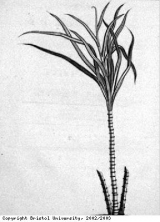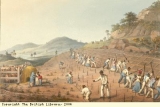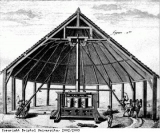The year’s work
The annual cycle of work on the plantations began in October. The work of growing sugar cane began with clearing the ground. Then the square plots were marked out and weeded and the soil loosened, in which the cane cuttings were planted. The ground was cleared and dug over, usually by hand using tools such as hoes. This was work for the ‘Great Gang’, the strongest workers. The cleared ground was marked into squares and a piece of cane stem was planted in each square. These cuttings took root in the ground and grew quickly. Weeding to keep the ground clear and adding manure was the work of the ‘second gang’. All plantations kept cattle, to provide meat, milk, and most importantly, manure for the sugar cane.
The sugar cane was ready for cutting after 15 to 18 months. It has to be cut when ripe. If cut too early or too late, the sugar will not crystallise properly. Cutting usually started in January on the plantation. Harvest meant hard work, as everything had to be done fast to make good sugar. The cut canes were taken to the sugar mill for crushing. This extracted the juice. The cane had to be crushed as soon as possible after cutting, and the juice was boiled as soon as possible after crushing. Delay could mean that the sugar would not crystallise. The sugar mill and boiler house worked 24 hours a day during harvest. The long hours could mean accidents. A worker in the sugar mill could lose an arm if their fingers were caught in the rollers. This picture shows a cattle-mill. Water, wind and steam were also used to power the machinery. Most of this equipment had to be imported. Colonies were expected to use goods manufactured at home in Britain, which were shipped out o them. This meant that the markets at home were not affected by competing manufacturing in the colonies.
The juice from the mill was run off to the boiling house. Here it was boiled until it started to crystallise. Sugar boiling was skilled and dangerous work. The boiling had to be continuous, and boiling sugar was ladled from one boiling pan to another. Accidents were common because of the long hours and the disruption of working four-hour shifts.
The boiling produced raw ‘muscavdo’ sugar. This was dark brown and sticky. It was shipped to Europe in ‘hogsheads’, barrels holding about 272 kilos, and further processed there to produce fine white sugar.
Once the harvest and sugar boiling was over, the slaves were allowed to relax a little. The end of harvest was celebrated in a ‘cropover festival’. The slaves were given a few days off, and might have food provided by their owner for a feast.
After that, it was back to work, as the cycle of planting, weeding and harvesting began all over again.





